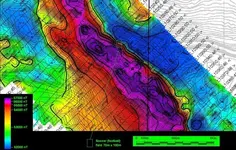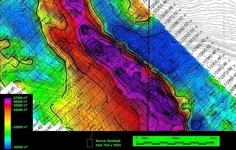Re: discussion on the various possible theories that may be applicable to LrL's
Oroblanco said:
J__P wrote
The brain uses many measuring/receptor frequencies. If we are talking about receiving signals, our eyes have a temporal resolution of about 15-20Hz, while the signals they process vary from 400–790 THz. Ears process signals between 20-20KHz. Several kinds of nerve endings in the sense of feel can detect sound or mechanical vibrations below 100Hz down to the sub-1Hz level depending on the kind of motion signal. And people can detect higher frequencies of mechanical motion with touch, but not with very good resolution. Smell? Not sure about any frequencies.
None of these frequencies run into the megahertz range, which is where gold is. What organs or sense would be detecting in the megahertz range? Thank you in advance,
Oroblanco
Hi Oroblanco,
The nuclear magnetic resonance of buried gold is not in the megahertz range.
This frequency of 1.729 MHz is an artificially modified frequency that scientists publish and use only when they place gold samples in a very strong magnetic field in a laboratory.
The NMR frequency of gold or any other element will increase with the strength of magnetic field it is exposed to. The reason why you read about the 1.729 Mhz frequency is because scientists need to expose it to a magnetic field 47,000 times stronger than the earth's field to reduce the background noise to a level where they can measure the frequency. In a natural environment of buried gold, or a ring in a jewelry store, the NMR frequency is in the audio range around 37 Hz. At this weak natural magnetic field strength, any nuclear magnetic resonating at 37 Hz is not discernable because it is lost in a huge amount of background noise. But this is not a clean 37 Hz. This is only an average frequency for atoms in a chunk of gold. Most of the gold atoms are not resonating at that frequency. At earth field strength, this is a very weak, sloppy signal buried in noise. Then there is the problem that the earth's magnetic field is not uniform. The field strength varies from around 30 μT to 60 μT at various locations. This means the NMR frequency of buried gold could be between 22Hz and 45Hz at different locations. These variations are not predictable either. They don't follow any convienient geographical formula, but show wierd anomalies all over depending on how the soil strata changes. There is some consistency that the field strength is stronger at the poles than at the equator. Did I mention that the magnetic field strength varies during the day, with repeating daily cycles, as well as cycles where the strength changes over longer periods of time? There are also variations over time which come as unexpected jumps when there are tremors and other geophysical events. We also have directional variations in this weak magnetic field which show a more horizontal field at the equator, and more vertical field at the poles.
The result is the NMR frequency of gold is poorly defined for gold that is buried in the ground, and un-measureable, and changing over short periods of time. If we are looking for resonance, we would first have to measure the local earth magnetic field strength, then calculate the expected frequency, with the understanding that the frequency will change as we walk along in our treasure hunt where the field strength is different. So prepare to carry a portable magnetometer. And prepare to try to detect a signal that needs a field 47,000 times stronger than where you're walking to be detectable above the noise floor. But most important, be prepared to detect a metal whose atoms are mostly not resonating at the frequency you calculated.
LRL users of MFD generators use frequencies they claim are the same as NMR frequencies.
But the frequencies they talk about using are usually different than this calculated amount. Some claim they are using harmonic frequencies.
Considering the fundamental frequency is buried in noise so it can't be measured until we increase the field 47,000 times, how can we expect to get a harmonic to resonate when it is even weaker, and is also an undefined frequency like the fundamental?
To give you an idea of how NMR frequencies change in a treasure hunting scenario, look at the map below. This is a magnetic survey map made by a geologist in a remote area where you might want to hunt for buried gold. Gold will have a NMR frequency that varies between 38.8 and 42.5 Hz at locations that are mapped below. Suppose you are standing in the lower left corner of the soccer field size area and measure the magnetic field where you are standing, then calculate you need to find gold resonating at 42 Hz. You take your super-exotic SQUID amplifier LRL that you figure can "sort of" see into the noise region and start walking northeast in search of gold. By the time you traveled 100 yards the calculated gold frequency has changed from 42 Hz to 39 Hz. How can you keep your detector resonating at the correct frequency? Built-in magnetometer correction?
That might work, but remember how we have a really sloppy frequency where most of the gold atoms are not resonating at the calculated frequency?
And guess what?
There are other elements with their harmonics which also are sloppily resonating in this same bandwith to confuse any detection you might make for gold. But these are no where near as strong as other noise signals that can set off the detector to think it might have found something. Considering we are looking for a super-tiny electromagnetic signal at around 40 Hz, how do we tell the difference from ELF noise signals millions of times stronger that can arrive at 40 Hz randomly or in patterns? How do we find these NMR gold signals from amongst the natural earth signal noises, man-made transmissions or electrical equipment noise, or possibly even biological 40 Hz noise from your nervous system as you treasure hunt?

This is a basic reason why the nuclear magnetic resonant frequency theory does not seem like a very promising explanation for LRL operation in treasure hunting.
Another reason is I never heard of anybody who has biological sensors, or who can make an electronic detector capable of detecting the direction of a 37 Hz electromagnetic signal from a substance that does not resonate at that frequency. In fact I can't imagine it happening if the buried gold found a way to magically start resonating at a coherent 37 Hz, considering it is in a magnetic field 47,000 times weaker than what is needed for a signal to rise above the noise floor.
Do you know of a human sense or practical man-made machine that can localize a sub-noise strength 37 Hz electromagnetic signal?
If so, will this method or machine work for anyone who wants to try it?
Thank you in advance,
Best wishes,
J_P










 snicker Can you actually imagine a two day walk, and he is going to use his spare sock for coffee? yeah You have to watch these Wyoming x coboy sheep lovers EE.
snicker Can you actually imagine a two day walk, and he is going to use his spare sock for coffee? yeah You have to watch these Wyoming x coboy sheep lovers EE.

